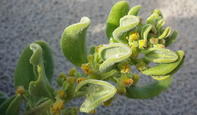Dune spinach (Tetragonia decumbens or ‘kinkelbos’ in Afrikaans) is a low-growing (0.1 - 0.3 m high) creeping shrub that is found in coastal areas such as on dunes near the sea. The plant is found from southern Namibia along the coastline to the Eastern Cape.

The trailing branches can be over 1 m long, rooting at intervals. Its dark green succulent leaves are covered with microscopic water-storage cells that glisten in the sunlight.
The four-petalled yellow flowers bloom from August to November and produce four-angled fruit in summer - the name ‘tetragonia’ refers to the four-sided fruits.
Dune spinach helps to stabilise the soil on dunes and forms organic matter which, in turn, provide a habitat for other plants to establish themselves. In addition, its leaves and stems are edible and are best harvested in winter.
Make sure to pick the leaves only and do not uproot the whole plant. Wash well to rid them of sand and eat raw in salads. When boiled, it loses some of its saltiness. Serve with butter on pasta (some cooks add sorrel), in potato salad and in stir-fries.
Growing Dune Spinach
Dune spinach is a fast-growing, low-maintenance plant that can be grown by replanting pieces of stem with roots attached. The plant is hardy and will thrive in sandy soils - ideal to stabilised dune areas.
It requires little watering, but it’s best to keep roots moist after replanting. The plant flowers in spring to early summer and bears fruit in summer. Dune spinach is relatively disease and pest-free.
By Marinda Louw